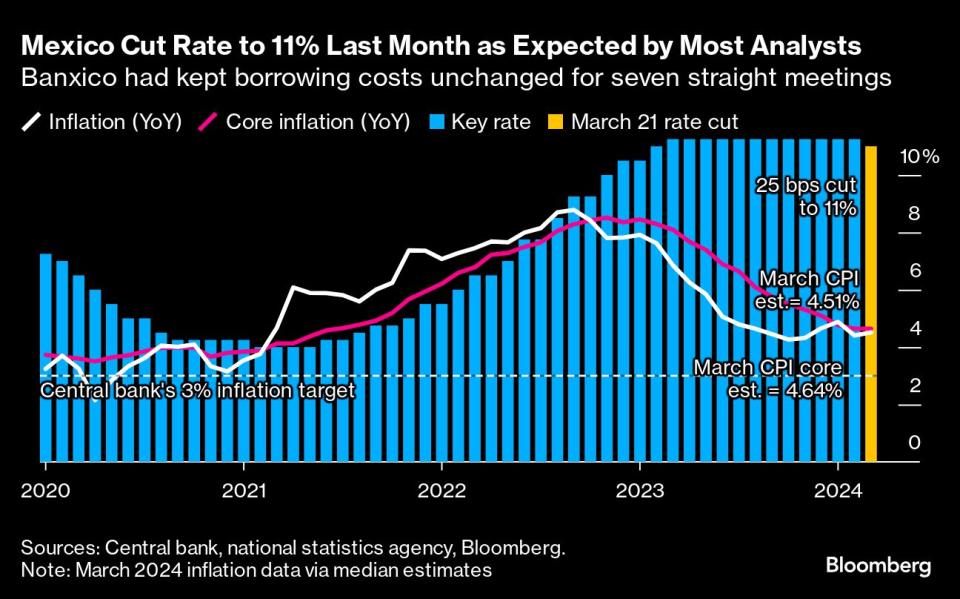Mexican Peso Volatility Isn’t Risk to Prices, Banxico Chief Says
(Bloomberg) -- The Mexican peso’s recent bout of volatility following rising tensions in the Middle East is not a concern for inflation, Banco de Mexico’s governor said amid expectations that the central bank will continue to be cautious in its upcoming monetary policy decision.
Most Read from Bloomberg
Trump Has Only $6.8 Million for Legal Fees With Trial Underway
TikTok to Remove Executive Tasked With Fending Off US Claims
Ray Dalio’s Famous Trade Is Sputtering and Investors Are Bailing
US Dollar’s Extended Reign Delivers Stark Wake-Up Call for Markets
Banxico, as the institution is often called, does not have an objective for the currency, but has kept an eye on the geopolitical factors that led to its swings, Governor Victoria Rodriguez said in an interview Saturday. Analysts are waiting to see the tone officials will strike in their May 9 decision, and whether they will choose to hold borrowing costs at the current level.
“The effect that we saw in recent days was reversed rapidly. We do not see it as a factor that is having an important impact,” she said the day after Mexico’s annual banking convention in Acapulco. “At this point it’s not a relevant risk. Of course, we are attentive.”
Read More: Mexico Likely to Hit Pause on Rate Cuts in May, Heath Says
The Mexican peso — widely considered a proxy for risk assets — plunged the most in four years on reports of increased tension between Israel and Iran, though it later reversed most of that slump. The peso has been the best-performing major currency in the last 12 months.
“We have a floating exchange rate and that serves as a variable to avoid that shocks are passed onto the real economy,” Rodriguez said. “We’re always watching the exchange rate to see that markets operate in an orderly way, and we haven’t seen anything relevant on that front recently.”
The central bank lowered borrowing costs by a quarter-point in the last meeting, and it’s expected to continue with gradual easing through the course of the year. Rodriguez reiterated in the interview that any changes would be “step-by-step.”
Read More: Latin America Sees Low-Rate Dreams Crumble, Political Woes Rise
The five-member board was split over whether it made sense to bring down rates to 11%, with one member stating that the strong domestic market and high inflation made such a move premature, according to minutes that were published after the last meeting. Latin American peers had in general eased earlier than Banxico while the Mexican institution had kept a close eye on sticky core price metrics that exclude food and fuel.
Rodriguez said that the peso’s strength has at some points helped contain inflation, since the cost of goods has not risen as quickly as before especially because of the effect on importers.
The peso’s strength has turned into a selling point for President Andres Manuel Lopez Obrador ahead of the June election, in which his ally Claudia Sheinbaum is running to succeed him. Volatility in recent days led the president to say that some weakening was beneficial, because the currency had become “too strong.”
The Bank for International Settlements and seven monetary policy authorities, including Banxico, recently announced that they will explore combining versions of tokenized central bank money and commercial bank deposits on a unified platform.
Read More: BIS and Central Banks to Test Tokenization of Cross-Border Payments
The timeline of that project will depend on the participation of the private sector, Rodriguez said.
“We’re working on a pilot exercise to make cross-border payments more efficient,” she added. “The goal is to find alternatives that make the payments cheaper, faster or more transparent.”
--With assistance from Robert Jameson.
Most Read from Bloomberg Businessweek
How a Massive Hack of Psychotherapy Records Revealed a Nation’s Secrets
What Really Happens When You Trade In an iPhone at the Apple Store
Rents Are the Fed’s ‘Biggest Stumbling Block’ in Taming US Inflation
©2024 Bloomberg L.P.




